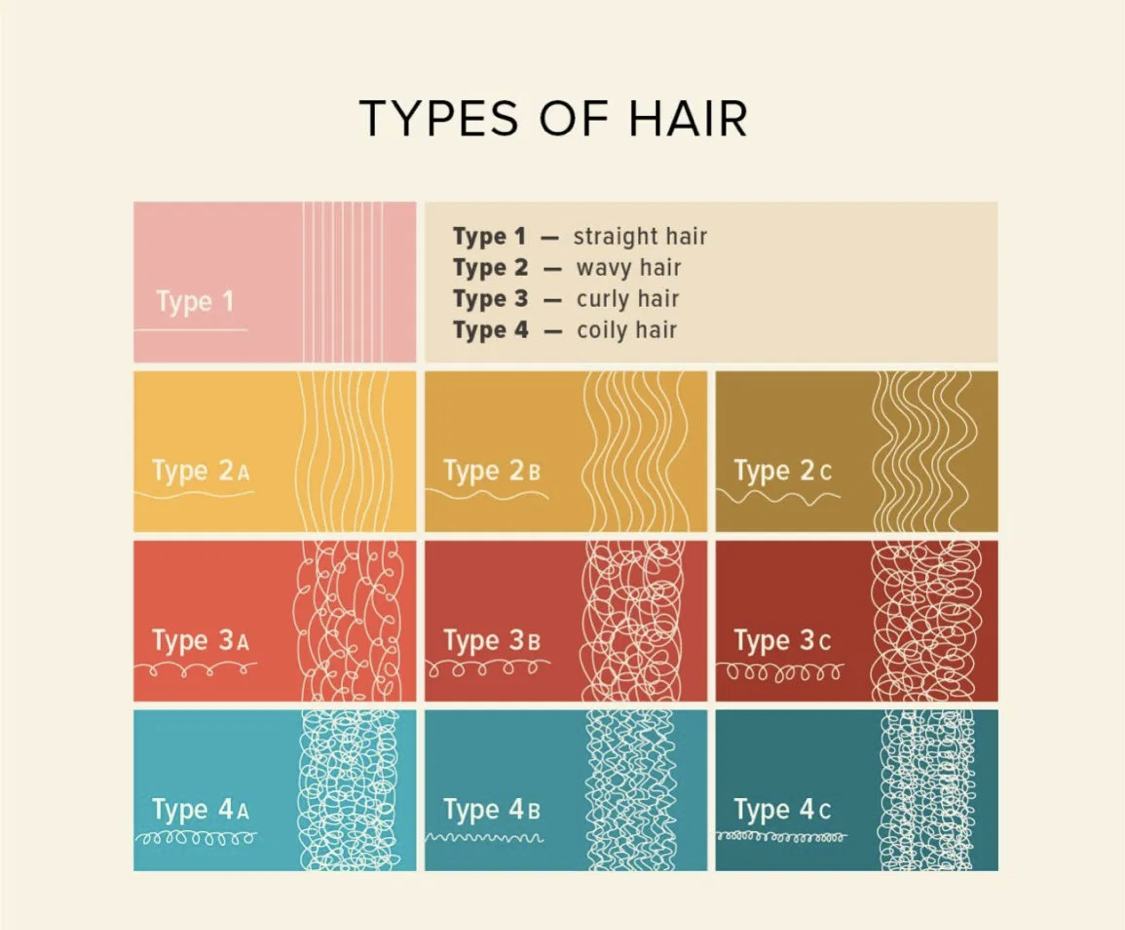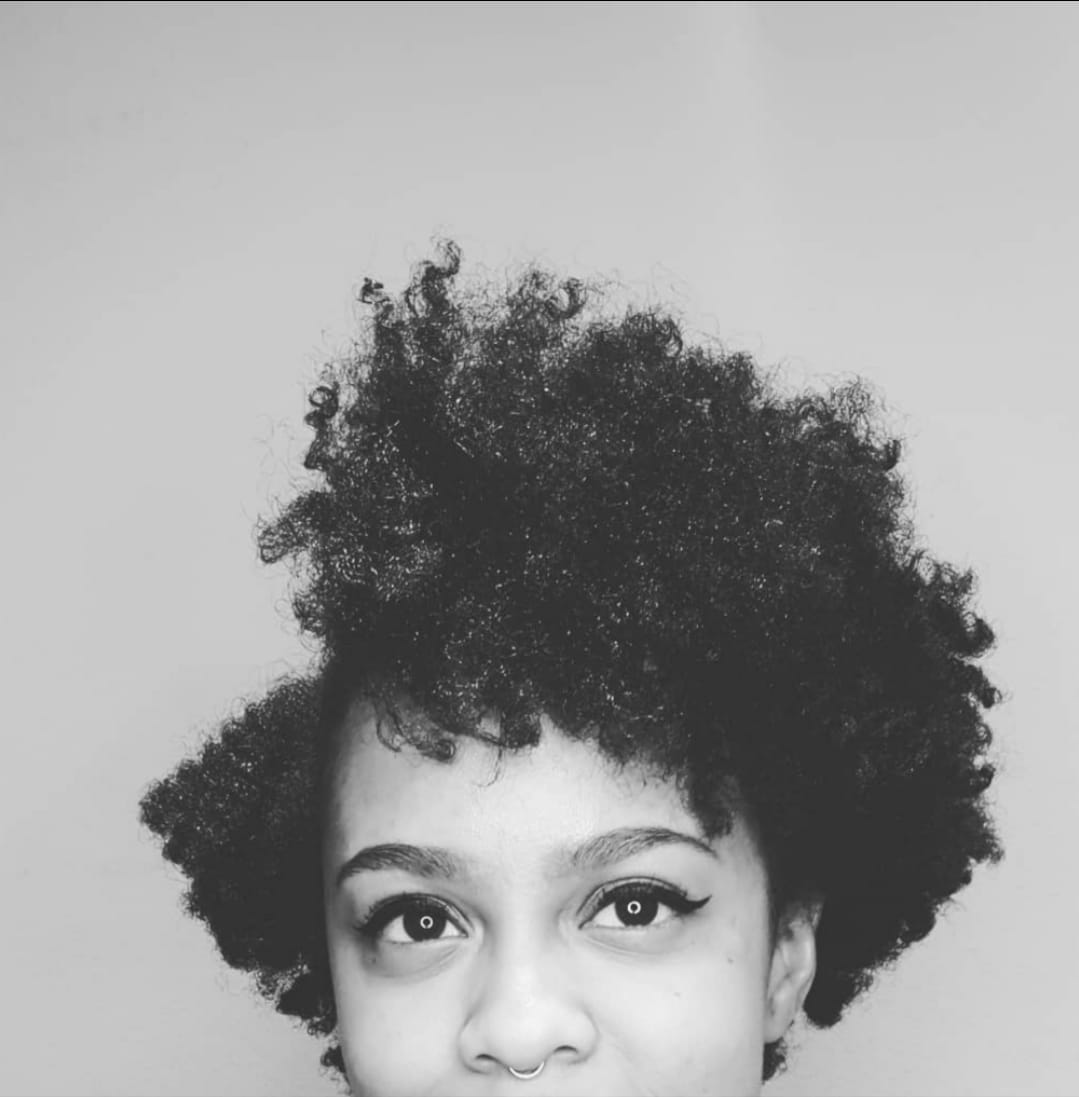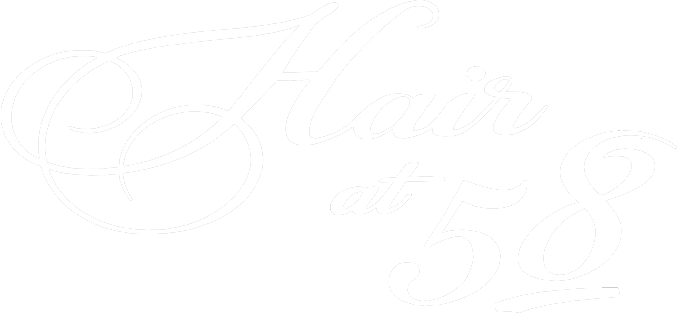
Curly Hair
Have you ever wondered what hair type you are? Use this guide below to find out..
This is the most widely used system to classify hair. According to this system there are four types
of hair: straight, wavy, curly, kinky, however you could have a more than one type throughout your
hair.
What does hair type mean?
Your hair type is primarily based on your hair’s curl pattern. The amount of curls in your hair is
determined by your hair follicle. The shape of your follicle determines whether your hair is straight
wavy, curly or coily.
The more oval or asymmetrical your follicle is, the curlier your hair will be. Your hair type is determine by genetics. You can alter your curl pattern with heat or chemicals, and your curl pattern can change
somewhat by hormones or medications you're taking, but your basic curl pattern is in your DNA.
Every time your hair goes through its growth cycle, those genetic characteristics are reasserted.
What hair types are there?
Andre Walker, known for decades as Oprah Winfrey is Stylist, is credited to devising a system that
classifies hair according to one of four curl patterns.
Straight hair, which reflects the most sheen and also the most resilient hair of all of the hair types. It is hard to damage and immensely difficult to curl this hair texture. Because the sebum easily spreads from the scope to the end without curls or kinks to interrupt its path, it's the most oily hair texture of all.

Type 1 -
Type 2 -
Wavy hair, whose texture and sheen ranges somewhere between straight and curly hair. Wavy hair is also more likely to become frizzy than straight hair. While ype A waves can easily alternate between straight and curly styles, Type B and Cwavy hair is resistant to styling causes less defined curls
Curly hair, known to have an S shape. The curl pattern may resemble a lowercase S or sometimes and uppercase Z. this hair type is usually voluminous (climate dependent, humidity = freeze) and damage prone, lack of proper care causes less defined curls.
Type 3 -
Kinky hair, which features a tightly coiled curl pattern (or no discrnible curl pattern at all) that is often fragile with a very high density. This type of hair shrinks when wet and because it has few cuticle layers than other hair types it is more susceptible to damage.
Type 4 -


These types are further divided into subcategories based on the tightness or looseness of the
curls and coils. It may sound simple but like most attempts to define human characteristics, it
isn’t; you could have type 4C at your crown and 4A at your temples. Your hair could be straight at the
roots and wavy at the ends. The key is to understand what each type needs so you can style it
well and keep it healthy.
1A - straight fine and thin this hair tends to be very soft thin shiny oily, poor at holding curls difficult to damage
1B - straight medium hair characterised by volume and body
1C - straight course hair tends to be bone straight course and difficult to curl
Type 1 - Straight
Type 2 - Wavy
2A - wavy fine and thin hair has definite S pattern, can easily be straightened or curled, usually receptive to a variety of styles.
2B - wavy medium can tend to be frizzy and a little resistant to styling
2C - WAVY COURSE FAIRLY COURSE, FUZZY OR VERY FUZZY WITH THICKER WAVES, OFTEN MORE RESISTANT TO STYLING.
3A - curly loose presents a definite S pattern, tends to combine thickness, volume, and or frizziness.
3B - curly tight present a definite S pattern, curls ranging from spirals to spiral shape to corkscrew
Type 3 - Curly
4A - kinky soft hair tends to be very wiry and fragile, tightly called coils and can feature curly patterning
4B - kinky Wiry as a four but with less defined patterns of curl, looks more like a Z with sharp angles
Type 4 - Kinky

This is a method which classifies the hair by curl pattern, hair strand thickness and all over hair volume.
The FIA System
Curliness
Straight
1A - stick straight
1B - straight but with a slight body wave adding some volume
1C - straight with body wave and one or two visible S waves e.g. at the nape of the neck or temples
Wavy
2A - LOOSE WITH STRETCHED S-WAVES THROUGHOUT
2B - SHORTER WITH MORE DISTINCT S-WAVE RESEMBLING EXAMPLE, BRAIDED DAMP HAIR
2C - DISTINCTIVE S WAVES, SOME SPIRAL CURLING
3A - BIG, LOOSE SPIRAL CURLS
3B - BOUNCY RINGLETS
3C - TIGHT CORKSCREWS
Curly
3A - BIG, LOOSE SPIRAL CURLS
3B - BOUNCY RINGLETS
3C - TIGHT CORKSCREWS
Very Curly
Density
Hair density refers to the number of hairs on you head. If you can’t see your scalp clearly, you
probably have dense hair. If you can see you scalp without parting your hair, you probably have low density hair.
Your hairs density can be effected by a number of factors, including stress, hormones during pregnancy or menopause or nutrition.
Strands
Fine
THIN STRANDS THAT SOMETIMES ARE ALMOST TRANSLUCENT WHEN HELD UP TO THE LIGHT. SHARED STRANDS CAN BE HARD TO SEE EVEN AGAINST THE CONTRASTING BACKGROUND. FINE HAIR IS DIFFICULT TO FEEL OR IT FEELS LIKE AN ULTRA FINE STRAND OF SILK
Straight
1A - stick straight
1B - straight but with a slight body wave adding some volume
1C - straight with body wave and one or two visible S waves e.g. at the nape of the neck or temples
Medium strands are neither fine nor course. Medium hair feels like a cotton thread, but
isn't stiff or rough. It is neither fine not coarse
Medium
THICK STRANDS WHOSE SHRED STRANDS USUALLY ARE EASILY IDENTIFIED. COURSE HAIR FEELS HARD AND WIERY
Coarse
Volume - By Circumference of Full-Hair Ponytail
THIN - CIRCUMFERENCE LESS THAN 2 INCHES OR 5 CM
NORMAL - FROM 2 TO 4 INCHES OR 5 TO 10 CM
THICK - MORE THAN 4 INCHES OR 10 CM
Heres a simple test you can do at home to test the porosity of your hair…
*Lay a few strands of your hair in a bowl of water.
*After a few minutes take a look.
*Hair that floats has low porosity. Hair that sinks has high Porosity
Take a look at the diagram at the top of the page to match your hair type

Curly Hair
Have you ever wondered what hair type you are? Use this guide below to find out..
This is the most widely used system to classify hair. According to this system there are four types
of hair: straight, wavy, curly, kinky, however you could have a more than one type throughout your
hair.
What does hair type mean?
Your hair type is primarily based on your hair’s curl pattern. The amount of curls in your hair is
determined by your hair follicle. The shape of your follicle determines whether your hair is straight
wavy, curly or coily.
The more oval or asymmetrical your follicle is, the curlier your hair will be. Your hair type is determine by genetics. You can alter your curl pattern with heat or chemicals, and your curl pattern can change
somewhat by hormones or medications you're taking, but your basic curl pattern is in your DNA.
Every time your hair goes through its growth cycle, those genetic characteristics are reasserted.
What hair types are there?
Andre Walker, known for decades as Oprah Winfrey is Stylist, is credited to devising a system that
classifies hair according to one of four curl patterns.
Straight hair, which reflects the most sheen and also the most resilient hair of all of the hair types. It is hard to damage and immensely difficult to curl this hair texture. Because the sebum easily spreads from the scope to the end without curls or kinks to interrupt its path, it's the most oily hair texture of all.

Type 1 -
Type 2 -
Wavy hair, whose texture and sheen ranges somewhere between straight and curly hair. Wavy hair is also more likely to become frizzy than straight hair. While ype A waves can easily alternate between straight and curly styles, Type B and Cwavy hair is resistant to styling causes less defined curls
Curly hair, known to have an S shape. The curl pattern may resemble a lowercase S or sometimes and uppercase Z. this hair type is usually voluminous (climate dependent, humidity = freeze) and damage prone, lack of proper care causes less defined curls.
Type 3 -
Kinky hair, which features a tightly coiled curl pattern (or no discrnible curl pattern at all) that is often fragile with a very high density. This type of hair shrinks when wet and because it has few cuticle layers than other hair types it is more susceptible to damage.
Type 4 -

These types are further divided into subcategories based on the tightness or looseness of the
curls and coils. It may sound simple but like most attempts to define human characteristics, it
isn’t; you could have type 4C at your crown and 4A at your temples. Your hair could be straight at the
roots and wavy at the ends. The key is to understand what each type needs so you can style it
well and keep it healthy.
1A - straight fine and thin this hair tends to be very soft thin shiny oily, poor at holding curls difficult to damage
1B - straight medium hair characterised by volume and body
1C - straight course hair tends to be bone straight course and difficult to curl
Type 1 - Straight
Type 2 - Wavy
2A - wavy fine and thin hair has definite S pattern, can easily be straightened or curled, usually receptive to a variety of styles.
2B - wavy medium can tend to be frizzy and a little resistant to styling
2C - WAVY COURSE FAIRLY COURSE, FUZZY OR VERY FUZZY WITH THICKER WAVES, OFTEN MORE RESISTANT TO STYLING.
3A - curly loose presents a definite S pattern, tends to combine thickness, volume, and or frizziness.
3B - curly tight present a definite S pattern, curls ranging from spirals to spiral shape to corkscrew
Type 3 - Curly
4A - kinky soft hair tends to be very wiry and fragile, tightly called coils and can feature curly patterning
4B - kinky Wiry as a four but with less defined patterns of curl, looks more like a Z with sharp angles
Type 4 - Kinky
This is a method which classifies the hair by curl pattern, hair strand thickness and all over hair volume.
The FIA System
Curliness
Straight
1A - stick straight
1B - straight but with a slight body wave adding some volume
1C - straight with body wave and one or two visible S waves e.g. at the nape of the neck or temples
Wavy
2A - LOOSE WITH STRETCHED S-WAVES THROUGHOUT
2B - SHORTER WITH MORE DISTINCT S-WAVE RESEMBLING EXAMPLE, BRAIDED DAMP HAIR
2C - DISTINCTIVE S WAVES, SOME SPIRAL CURLING
3A - BIG, LOOSE SPIRAL CURLS
3B - BOUNCY RINGLETS
3C - TIGHT CORKSCREWS
Curly
3A - BIG, LOOSE SPIRAL CURLS
3B - BOUNCY RINGLETS
3C - TIGHT CORKSCREWS
Very Curly
Density
Hair density refers to the number of hairs on you head. If you can’t see your scalp clearly, you
probably have dense hair. If you can see you scalp without parting your hair, you probably have low density hair.
Your hairs density can be effected by a number of factors, including stress, hormones during pregnancy or menopause or nutrition.
Strands
Fine
THIN STRANDS THAT SOMETIMES ARE ALMOST TRANSLUCENT WHEN HELD UP TO THE LIGHT. SHARED STRANDS CAN BE HARD TO SEE EVEN AGAINST THE CONTRASTING BACKGROUND. FINE HAIR IS DIFFICULT TO FEEL OR IT FEELS LIKE AN ULTRA FINE STRAND OF SILK
Straight
1A - stick straight
1B - straight but with a slight body wave adding some volume
1C - straight with body wave and one or two visible S waves e.g. at the nape of the neck or temples
Medium strands are neither fine nor course. Medium hair feels like a cotton thread, but
isn't stiff or rough. It is neither fine not coarse
Medium
THICK STRANDS WHOSE SHRED STRANDS USUALLY ARE EASILY IDENTIFIED. COURSE HAIR FEELS HARD AND WIERY
Coarse
Volume - By Circumference of Full-Hair Ponytail
THIN - CIRCUMFERENCE LESS THAN 2 INCHES OR 5 CM
NORMAL - FROM 2 TO 4 INCHES OR 5 TO 10 CM
THICK - MORE THAN 4 INCHES OR 10 CM
Heres a simple test you can do at home to test the porosity of your hair…
*Lay a few strands of your hair in a bowl of water.
*After a few minutes take a look.
*Hair that floats has low porosity. Hair that sinks has high Porosity
Take a look at the diagram at the top of the page to match your hair type


